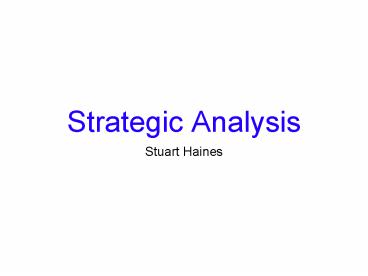Strategic Analysis - PowerPoint PPT Presentation
1 / 33
Title:
Strategic Analysis
Description:
Adapted from Porter M (1980) Porter's 5 Forces. Threat of Entry. Buyer Power. Supplier Power ... Adapted from Porter (1985) The Value Chain. The Value Chain ... – PowerPoint PPT presentation
Number of Views:49
Avg rating:3.0/5.0
Title: Strategic Analysis
1
Strategic Analysis
- Stuart Haines
2
Strategic Analysis
- Strategic Environment
- 5 Forces Analysis
- Cultural Web
- Organisational Competence
- Value Chain
- Cost Efficiency
3
Strategy is best considered alongside political
and cultural issues.
4
Clinical Team
Clinical Directorate
Trust
Health Economy
SHA
NHS
HM Government
Strategic Analysis
5
PEST
- Analysis of Environmental Influences
6
What environmental factors affect the
organisation?
Political/legal Factors
Economic Factors
Socio-cultural Factors
Technological Factors
Which of these are the most important now, in the
medium and in the long term?
7
Competitive Environment5 Forces Analysis
Johnson G Scholes K (1999) Adapted from Porter
M (1980)
8
Porters 5 Forces
- Threat of Entry
- Buyer Power
- Supplier Power
- Threat of Substitutes
- Competitive Rivalry
9
1. Threat of EntryLargely depends on barriers
to entry
- Economies of Scale
- Capital Requirements of Entry
- Access to Distribution Channels
- Cost advantages independent of size
- Expected retaliation
- Legislation or government action
- Differentiation
10
2. Power of BuyersBuyer power is high when
- Concentration of buyers - especially volume
purchasers - The supplying industry has large number of small
operators - Alternative sources of supply
- Cost of switching supplier involves little risk
- There is a threat of backwards integration from
the buyer
11
3. Power of SuppliersSupplier power is high when
- Concentration of suppliers, rather than
fragmented source of supply - Switching costs from one supplier to another are
high - Brand of the supplier is high
- Possibility of supplier integrating forwards
- Suppliers customers are highly fragmented so
their bargaining power is low
12
4. Threat of Substitutes
- Product-for-Product substitution
- Substitution of Need
- Generic Substitution
- Doing Without
13
5. Competitive Rivalry
- Extent to which competitors are in balance
- Market growth rates affect rivalry
- Existence or development of global customers
- High fixed costs in an industry
- Addition of extra capacity in large increments
- Differentiation
- Acquisition of weaker competitors
- High exit barriers in an industry
14
Compete or Collaborate?
- Collaborating adds greater value to the
organisation than when its on its own - Collaborating allows an organisation to
concentrate on its core skills - avoiding wasted
peripheral activities
15
The Cultural Web
- Analysis of Internal Cultural Influences
16
Understanding the culture of an organisation is
important but not straightforward.
Dont make assumptions. Underlying
assumptions are only evident from talking to
people.
How do people behave towards each other?
17
Why map culture?
- Surface what we take for granted so that we can
question them. If we dont question what we take
for granted, change is difficult. - See where barriers to change are.
- See linkages between aspects where there is
particular resistance to change. - Can map what change is necessary to deliver new
strategy. - See whether such change is sustainable.
18
Symbols
Stories
Power Structures
Rituals Routines
The Paradigm
Control Systems
Organisational Structures
The Cultural Web
19
Stories
Cures
Villains (politicians managers)
Heroes heroism
Change agents are fools
Managers are abused
There was a Golden Age
20
Symbols
Terminology
White coats/uniforms
Mobile phones/bleeps
Doctors dining room
Big institutions
Royal
University connection
21
Power Structures
Fragmented
Professional bodies
Doctors
Senior Clinicians
Old-Boy network
Politicians
22
Organisational Structures
Hierarchical
Mechanistic
Pecking order of services
Tribal/functional
23
Control Systems
Financial reporting
Waiting lists
Consultant episodes
Professional responsibility
24
Rituals Routines
Clinical rituals
Consultation ceremonies
Patient infantilising
Waiting rooms
Putting to bed
Waking up
Ward rounds
Blaming the next tier
25
The Paradigm
NHS is a good thing
Public service
Free at the point of need
Clinicians values
Providers know best
Acute sector superior
Ours
26
Does the culture support the kind of organisation
you need?
Symbols
Stories
Power Structures
Rituals Routines
The Paradigm
Control Systems
Organisational Structures
The Cultural Web
27
The Competence of the Organisation
- Getting right what you do best
28
The Value Chain
Firm Infrastructure
Human Resource Management
Support Activities
Technology Development
Procurement
Margin
Inbound Logistics
Service
Marketing Sales
Outbound Logistics
Operations
Primary Activities
Adapted from Porter (1985)
29
The Value Chain
Supplier Value
Your Value
Buyers Value
30
Identify Core Competences
- Identify SBUs that are clearly successful
- Identify the bases of perceived value by
customers - Unpack each base of success - why are the SBUs
successful? - Unpack secondary reasons for success
- Look for patterns of explanation
31
Primary
Secondary
Tertiary
Success
Good Service
Rapid Response
Flexibility
Solving Patients Problems
Staff Discretion - rule bending
Good relations - GPs
32
Analysing Cost Efficiency
- How effective are your processes?
33
Economies of Scale
Experience
Cost efficiency
Product/process design
Supply Costs































